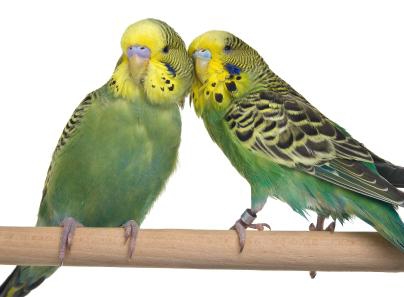Budgies
Budgerigars are friendly, cheerful companions for all age groups.
The budgerigar is a member of the parrot family and originates from Australia. Budgerigars are available in attractive and a sometimes unusual range of colours.
It is not possible to correctly sex very young budgies until they are at least three months.
Always take your bird home in a carry box, not in a cage.
The average life span of the budgerigar is 7-8 years.
CHOOSING AND BUYING YOUR BUDGERIGAR
A healthy budgerigar should be:
- Bright and alert
- Have no signs of discharge from the eyes or nostrils
- Have a clean vent area
- Feathers should be flush to the body and not be fluffed up
- Should have no signs of breathing problems
- Movement should be fluent with no signs of lethargy
HOUSING
Budgerigars can be kept in flocks in aviaries, or in cages either alone or in pairs. A roomy cage is advisable and should be large enough for your budgie to stretch its wings and fly from perch to perch.
Budgies are climbing birds so it is preferable to choose a cage with horizontal bars. A removable tray will make cleaning easier.
You should avoid putting the cage in draughts, direct sunlight or in damp or humid conditions. Sandsheets or cage bird sand should be placed in the bottom of the cage and replaced regularly.
The cage should be furnished with perches of different diameter and one or two toys, but do not overcrowd the cage. Try and buy a selection of toys and rotate them to avoid boredom.
Remove droppings daily. The cage and furnishings should be thoroughly cleaned and disinfected with a pet-safe disinfectant weekly.
Do not place perches directly above food and water pots.
INTRODUCING YOUR BUDGIE TO HIS NEW HOME
Before introducing your budgie to his new home fill the food and water pots and sprinkle a little extra onto the floor to ensure that he has enough to eat until he finds his seed pots.
Make sure all windows and doors are closed and fires are guarded. Gently open one end of the carry box and let your budgie walk into his new home.
If he appears anxious or does not settle drape a cloth over three sides of the cage until he settles. This can be gradually removed as he settles. Leave him to adjust quietly.
Only cover the cage at night if the room temperature is likely to fall.
Outside aviaries must have a sheltered section to provide protection from wind, rain and strong sunlight. This is where you should position the roosting site (the highest perch or nest box) and the food containers.
Aviaries should be suitably furnished with branches of different widths.
Do not place perches directly above food and water pots.
FEEDING AND WATER
A good quality budgie mixture should be available from your pet shop. Check the seed dishes daily and remove any empty husks. Refill as necessary.
Millet seed can be given as a treat as can honey bells and seed bars. Fresh thoroughly washed green-food may be given, such as lettuce, chick-weed and dandelion. Be careful not to over feed though.
Cuttlefish is a source of calcium and helps to keep the beak worn down. A mineral block will provide essential minerals and trace elements.
Grit helps with the digestion and should always be provided. Food and water pots should be washed regularly.
Fresh water should always be available.
GENERAL CARE
Properly cared for your budgie will live a long and happy life.
- Feathers – These should not be allowed to become too dry. You should use a suitable fine mist spray, together with a special solution to spray on. Your pet shop will advise. Some budgies do enjoy a bath but not all.
- Colds – Chilling causes colds. The bird will be listless, with feathers fluffed up and wheezing. Keep him warm and do not bath. Consult with your vet.
- Diarrhoea – This is commonly caused by an excess of green food, mouldy or contaminated food, a change in diet or lack of fresh water. Keep him warm, make sure he has plenty of fresh water and consult your vet.
- Mites – Usually the red mite, this is a parasite which feeds on birds’ blood, causing itching and weight loss. Mites are easy to destroy with a suitable spray. Your pet shop or vet will advise.
- Beaks and nails – Should they become overgrown you will need to get expert help.
- Feather plucking – This can be due to a poor diet, lack of exercise or stimulation. Spend time with your budgie and provide novel toys. If the condition persists consult your vet.

Shopping List
- Cage and cage stand
- Water pot
- Seed pot
- Perches
- Budgie care book
- Bath
- Food
- Toys
- Sand/sand sheets
- Grit
- Cuttlefish
- Mineral block
- Pet safe disinfectant
